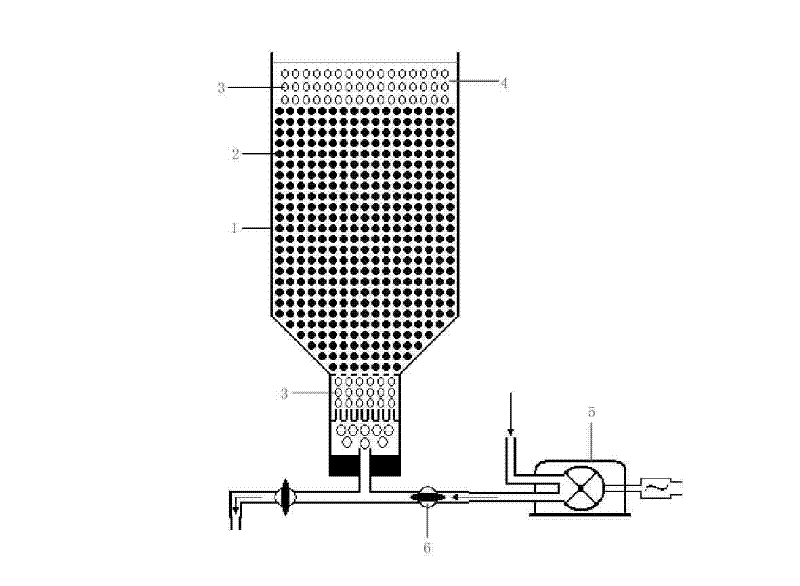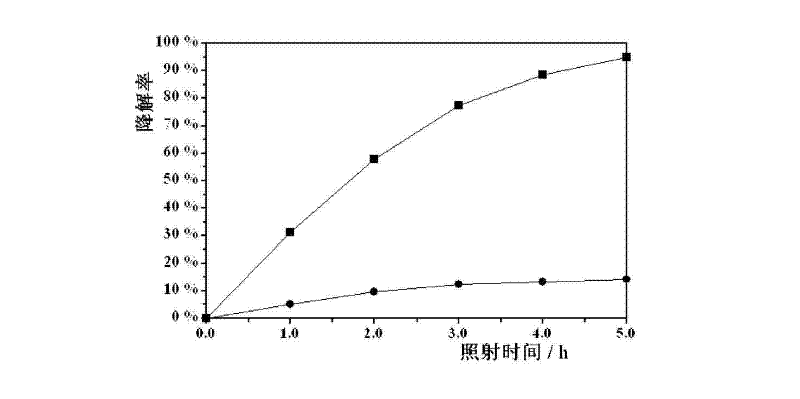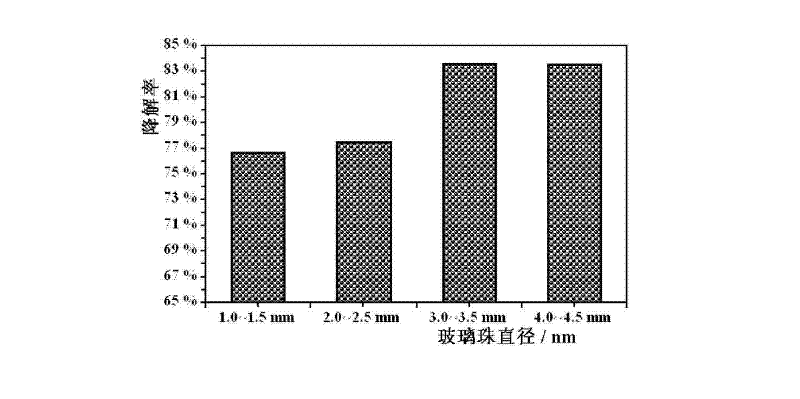Bubbling cavitation method for degrading organic pollutants in wastewater
A technology for organic pollutants and wastewater, applied in the direction of oxidized water/sewage treatment, etc., can solve the problems of difficult to achieve industrialization, low degradation efficiency, lack of ultrasonic cavitation technology, etc.
- Summary
- Abstract
- Description
- Claims
- Application Information
AI Technical Summary
Problems solved by technology
Method used
Image
Examples
Embodiment 1
[0030] Example 1 Degradation of Organic Pollutants in Wastewater by Bubbling Cavitation——Effect of Bubbling Time on Degradation Rate
[0031] Proceed as follows:
[0032] 1) Glass beads with a diameter of 2.0-2.5 mm are added to the degrader, and the amount of glass beads added is three quarters of the volume of the degrader;
[0033] 2) Adjust the concentration of acid red B aqueous solution to 10 mg L -1 , the acidity is pH=6.0, add in the degrader, the addition is 3cm higher than the glass beads;
[0034] 3) Gas is introduced from the bottom of the degrader, and the gas flow rate is controlled at 4.5 L min -1 , react for 1 to 5 hours. Samples were taken at different times to measure the UV-vis spectrum, and the concentration of the acid red B aqueous solution was determined. Quantitative analysis was carried out by UV-vis spectrophotometry. A series of acid red B solutions were scanned by UV-vis spectrum to determine the wavelength of the maximum absorption peak (λ...
Embodiment 2
[0037] Example 2 Degradation of Organic Pollutants in Wastewater by Bubbling Cavitation——Effect of Glass Bead Diameter on Degradation Rate
[0038] Proceed as follows:
[0039] 1) Glass beads with a diameter of 1.0-1.5 mm, 2.0-2.5 mm, 3.0-3.5 mm and 4.0-4.5 mm are added to the degrader, and the amount of glass beads added is three quarters of the volume of the degrader;
[0040] 2) Adjust the concentration of acid red B aqueous solution to 10 mg L -1 , the acidity is pH=6.0, add in the degrader, the addition is 3cm higher than the glass beads;
[0041] 3) Gas is introduced from the bottom of the degrader, and the gas flow rate is controlled at 4.5 L min -1 , reacted for 3 hours. Using UV-vis spectrophotometry (λ max = 510 nm) to measure the concentration of the solution, and calculate the degradation rate of acid red B from the concentration change. The result is as image 3 .
[0042] The diameter of the glass beads determines the size and number of air bubbles blow...
Embodiment 3
[0043] Example 3 Degradation of Organic Pollutants in Wastewater by Bubbling Cavitation——Influence of Initial Concentration on Degradation Rate
[0044] Proceed as follows:
[0045] 1) Glass beads with a diameter of 2.0-2.5 mm are added to the degrader, and the amount of glass beads added is three quarters of the volume of the degrader;
[0046] 2) Adjust the initial concentration of acid red B aqueous solution to 5 mg·L respectively -1 , 10mg·L -1 , 15mg·L -1 , 20mg·L -1 , 25mg·L -1 , the acidity is pH=6.0, add in the degrader, the addition is 3 cm higher than the glass beads;
[0047] 3) Gas is introduced from the bottom of the degrader, and the gas flow rate is controlled at 4.5 L min -1 , reacted for 3 hours. Using UV-vis spectrophotometry (λ max = 510 nm) to measure the concentration of the solution, and calculate the degradation rate of acid red B from the concentration change. The result is as Figure 4 .
[0048] The initial concentration of wastewater s...
PUM
| Property | Measurement | Unit |
|---|---|---|
| diameter | aaaaa | aaaaa |
| diameter | aaaaa | aaaaa |
| diameter | aaaaa | aaaaa |
Abstract
Description
Claims
Application Information
 Login to View More
Login to View More - R&D
- Intellectual Property
- Life Sciences
- Materials
- Tech Scout
- Unparalleled Data Quality
- Higher Quality Content
- 60% Fewer Hallucinations
Browse by: Latest US Patents, China's latest patents, Technical Efficacy Thesaurus, Application Domain, Technology Topic, Popular Technical Reports.
© 2025 PatSnap. All rights reserved.Legal|Privacy policy|Modern Slavery Act Transparency Statement|Sitemap|About US| Contact US: help@patsnap.com



